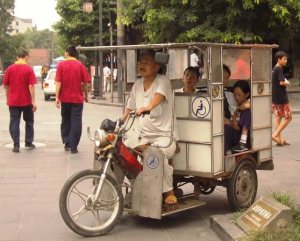
Our motor-taxi and its driver.The motorcycle taxi does not have much power, but it makes up the deficiency and more with its flexibility, or its driver’s flexible interpretation of the law. When the traffic was jammed, our motor-taxi dexterously switched between lanes for motorized vehicles and bikes, and sidewalks for pedestrians. When the traffic light turned red, our motor-taxi ignored the light or drove onto the crosswalk, side by side with pedestrians crossing the road. And when the jam became really bad, due to a fire at a building by the side of the road, we drove onto lanes and sidewalks on the other side of the road, or into small alleys. It is a hair-raising experience to see cars coming at you from all directions, but in the end, we all survived the rides with nary a scratch. As a matter of fact, since we (besides Agnes) liked it so much, and we practically had no other choice, we took the same motor-taxi back to downtown Chengdu.After a few weeks of staying on the road in China, I came to some appreciations to the intricacies of road practices. First, laws and rules are somewhat followed, but with generous latitude. Not considered set in stone, they are subject to on-the-situation interpretations. It’s not just the drivers that bend the laws to suit, the police and road maintenance crews also assumed as much—when there are traffic accidents or road repair works, no detours or temporary traffic control markers/personnel are set up; rather, the drivers themselves must work around the problems, and come up with workable alternatives.
Second, there are some implicit rules that everyone follows. One of these is that an act is likely acceptable if it does not stop the traffic outright. Another is that if you can get to a place first—be it the middle of an intersection or part of a lane for the on-coming traffic—you can assume you have the right of way.

Driving on the wrong side of the road, where there is only a partial lane due to a stopped vehicle.

In front of us, another motor-taxi, and a utility tricycle, crossing the busy traffic.
(The practice in Beijing has changed quite a bit in the last few years, and is now much less flexible than that described above. This might be a legacy of the 2008 Summer Olympics.)
 Here is a set of pictures of scooter riders on a rainy day. Note the police cars in the background. What I failed to capture are people wearing construction hard-hats or combat helmets, but those were spotted on more than one occasion.
Here is a set of pictures of scooter riders on a rainy day. Note the police cars in the background. What I failed to capture are people wearing construction hard-hats or combat helmets, but those were spotted on more than one occasion.
Count-down timers on traffic signals are something we wish we can have in the US. These are not universal in China, but can be seen in several cities.